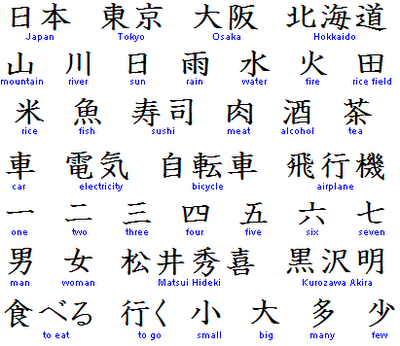Kanji MADNESS!
~Now that I've learned hiragana and katakana, it's time to tackle the third Japanese writing system: KANJI! By far the most complicated and difficult of the three, kanji (which literally translates to "Chinese characters") are a form a writing that were brought to Japan by Buddhist monks from China in the 5th century. They are a form of picture-writing, where each symbol represents an entire word. Here are some examples of common kanji:
 ^ I know about half of these...I'm still working on the rest!
^ I know about half of these...I'm still working on the rest! Today, there are over 50,000 kanji, but Japanese citizens are only expected to know the approximately 2,000 kanji on the "Jōyō kanji", an official list of common symbols compiled by the government. The number changes from year to year as some symbols are dropped from the list and others are added; currently, the Jōyō kanji has 1,945 symbols. Japanese students continuously study them in school and are regularly tested; by the end of high school, they are expected to know them all. As for me, I use the book 'Essential Kanji' by P.G. O'Neill, which presents the entire Jōyō kanji in a marginally-easy to learn form.
Today, there are over 50,000 kanji, but Japanese citizens are only expected to know the approximately 2,000 kanji on the "Jōyō kanji", an official list of common symbols compiled by the government. The number changes from year to year as some symbols are dropped from the list and others are added; currently, the Jōyō kanji has 1,945 symbols. Japanese students continuously study them in school and are regularly tested; by the end of high school, they are expected to know them all. As for me, I use the book 'Essential Kanji' by P.G. O'Neill, which presents the entire Jōyō kanji in a marginally-easy to learn form.Complex kanji are derived from simpler kanji, or even hiragana and katakana symbols. This means that a person knowledgeable in kanji can often determine the meaning of the symbol by drawing upon their existing knowledge. For example, when a native English reader sees a new word, they can often deduce its basic meaning from word parts, prefixes, suffixes, etc. All kanji contain radicals, comparable to the word parts of English words. Compared to the thousands of kanji, there are "only" 214 radicals. Here's an example of a simple kanji being used as a radical in a more complex kanji:
山 --------> 岡